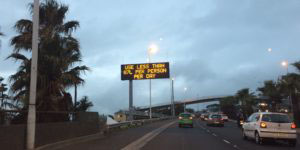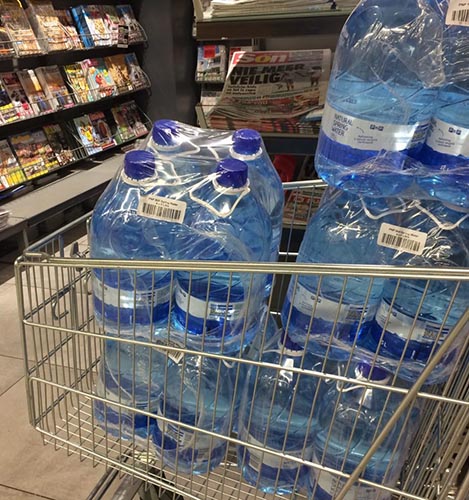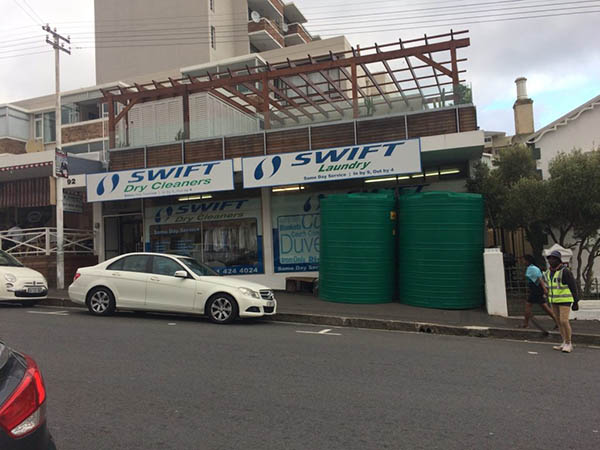Every morning before heading in to work, Lusanda weaves his way through shacks and sandy puddles, bucket in hand. The communal tap he uses is some fifty meters away. It’s relatively close, compared to some other settlements. “The problem is that tap there,” he explains pointing off in the distance, “If the tap is open there, this one will shut down, so I’ll have to wait for those ones to finish and fill up. That’s why all the time I keep my bucket full.” It is especially bad on Saturdays, when everyone is doing their laundry, so he strategically times the trip. Lusanda makes this journey twice every day, filling up a twenty-liter bucket, which he shares with his girlfriend. A couple of liters here for washing, a couple there for cooking and cleaning, all judiciously scooped from the bucket.

The communal tap. Image: Melissa Wrapp.
In a few short months, Cape Town will become one of the first major cities in the world to run out of water. Over the last three years, the city has experienced a severe drought, which University of Cape Town hydrologist Piotr Wolski describes as the “kind of drought [that] occurs once in 311 years.” Moreover, long-term climate models suggest lower levels of rainfall are likely in the future. Water scarcity is here to stay. In March 2017, Mayor Patricia de Lille declared the city a disaster zone in order to reallocate funds toward ramping up emergency water augmentation schemes, including contracts for multi-million rand desalination plants. I arrived for my fieldwork year the following month, as apocalyptic images of the bone-dry dams that feed the municipal water supply began swirling around social media.
On “day zero”, the taps will be turned off and residents will be forced to queue at collection points, under military guard, for a daily allotment of water. Water saving measures to avert this eventuality abound, from low-tech (like bathing in basins and reserving grey water for toilet flushing) to more costly solutions (like grey water recycling systems). A robust public awareness campaign, coupled with daily limits on municipal water consumption, has led many to develop a new sense of consciousness around water use.

Sign over the N2 highway. Image: Melissa Wrapp.
This is the so-called “new normal” of climate change, in the words of local politicians. And yet, for Lusanda, queuing, communal taps and conscious water-use are nothing new. For decades, poor black residents living informally have relied on the “bucket system” for water and sanitation, an infrastructural artifact of a city that was never designed for them to live in permanently. How do public awareness campaigns around water scarcity resonate in a context of extreme inequality? In this post, I will bring three brief vignettes together in order to reflect on this question, and consider emergent practices and politics surrounding day zero.
I turn in the queue, waiting to pay for my groceries, and flick my eyes over the front of the Cape Argus. “74 DAYS TO DAY ZERO” is emblazoned on the front page, a daily countdown superimposed over the image of a droplet from a tap. Beneath it, a photograph of faith leaders on their knees, literally praying for rain. A svelte, be-spandexed blonde couple behind me is eyeing an orchid that someone has abandoned amongst the candy bars. As she fingers its tendrils delicately, he dutifully remarks, “It would be irresponsible to buy a flower now…” She knits her brow and he finishes the thought, “…because of the water crisis. Actually-“ he starts, and then disappears from the queue. He returns a few moments later with a twelve pack of one liter water bottles hoisted athletically onto his shoulder. “Is this the kind we get?” she asks absentmindedly, returning her attention to the flower. “Dear,” he intones, as if she hasn’t quite grasped the gravity of the situation, “water is water.”
As day zero is continually recalculated (based on the previous week’s daily consumption average), the level of water restrictions has gradually escalated. “Level 4 water restrictions have been implemented- residents are limited to 100 liters per person per day” a radio ad announced in May, the amount soon reduced to 87, and ultimately to the current 50 liters (13 gallons). Electronic signs over the freeways with the current dam levels- “CRITICAL WATER SHORTAGE! DAMS AT 9.9%!”- serve as a constant reminder to Capetonians of the crisis. Sales of bottled water have surged, as have sales of “JoJo” water storage tanks, particularly in wealthier areas of the city. A woman anxiously confessed to me over a Rotary Club brunch that a man in her security estate had recently purchased 500 five-liter bottles of spring water. “He’s got them piled in his sitting room! It really starts to make you panic.”

Shopper stocks up on 5 liter bottles. Image: Melissa Wrapp.
The “best whites” in Cape Town, in South African journalist Rebecca Davis’ sardonic phrasing, are “checking their privilege, and then checking to make sure everyone has noticed.” Across the city and the suburbs, there are conspicuous signs of saving and water consciousness. The Premier for the province, to take one prominent example, has taken to tweeting out photos of her bathing habits, imploring that the only way to avoid day zero is to save. This fixation on saving is coupled with obsessive worrying. What are the current dam levels? What’s the weather forecast look like? Have your colleagues stopped flushing at work? Should we get another JoJo in? In writing of people who are “white-and-worried-about-the-nation”, anthropologist Ghassan Hage posits, “There are many people for whom worrying is the last available strategy for staying in control of social processes over which they have no longer much control.” To worry is to be in an uncertain position. But to worry is also to believe that you are entitled- expectant that you are in control of circumstances and used to being able to change them. For you, infrastructure (physical and otherwise) works. After all, you pay your rates.

JoJo water storage tanks. Image: Melissa Wrapp.
The first meeting of the Water Crisis Coalition, a loose collective of civil society organizations (feeling their way into a kind of alliance against “water privatization”), was buzzing with energy. The auditorium was filled with more than 70 different groups, from neighborhood associations on the posh Atlantic Seaboard to revolutionary socialist activists to academic researchers. Some openly expressed that they had “never seen anything like this” kind of diversity of representation in a public gathering. Yet tensions ran just beneath the surface.
Many present were angry about water management devices, which can track water usage and cut off supplies (in instances of “overuse”, but also nonpayment). Though these “WMDs” (as one activist put it) have been in use since 2010, 33,000 new devices have been fitted by the city since October in an aggressive campaign that ostensibly targets “water wasters”. The meeting was flooded with people from various townships describing leaking devices giving false readings of their use, exorbitant bills they couldn’t account for, and long, unexplained periods of water shut off. Some thirty minutes into the meeting, a white woman frantically interjected: “I’m sorry to interrupt, but honestly I’m very frustrated. In 100 days there’s going to be no water. All we’re sitting here talking about is water management systems- they’ll be irrelevant!”
The refrain “water is life” echoes in Cape Town. And because everyone is dependent on water, there is a sense collectivity in facing this crisis. We all need water. We all will suffer. We all will have to queue. We all need to save. “Together, we can avoid day zero” is the city’s PR mantra. Behind this “together” is an implicit “we are all equal” before this crisis. And yet, ironically, it is this very unreflective appeal to togetherness that reinscribes racial and economic inequalities. To invoke crisis, worry, and panic is to silence the voices of those who are already living in that feared and unimaginable world, and who possess vital insight into the experience of new (and far too old) water management regimes, forms of community organizing, and mutual support.
Water scarcity and inequality are on the rise globally. By putting these three vignettes into alignment, I wish to suggest that racial and economic inequality is not erased in the face of disaster, but potentially exacerbated, and that conservation and crisis planning must center marginalized voices in order to be effective. Any attempts to compel collective action in the face of water crisis will ring hollow without acknowledgement of, and accounting for, the differential impact of global climate change on the poor. While wealthier, whiter residents of Cape Town frantically adjust to tracking their water use, desperately hoping to avoid day zero, for many day zero arrived a long time ago. One suspects much of this urgency is motivated by a fear, rather than a belief, that we are really “all in this together”.
References
Davis, Rebecca. 2015. Best White and Other Anxious Delusions: Pan MacMillan South Africa.
Hage, Ghassan. 2000. White Nation: Fantasies of White Supremacy in a Multicultural Society: Routledge.

1 Comment
Great read, wena!
Day Zero now shifted out to 11 July but hopefully water wise habits will continue to grow.